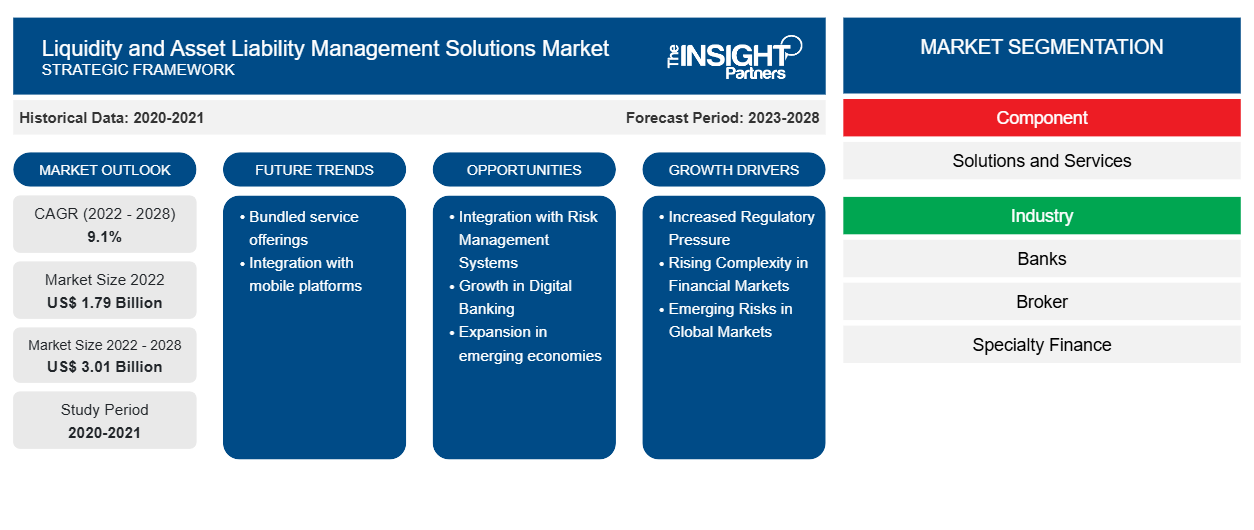流動性および資産負債管理ソリューションの市場規模は、2022年の17億8,759万米ドルから2028年には30億924万米ドルに拡大すると予測されており、2022年から2028年にかけて9.1%のCAGRで成長すると推定されています。
流動性管理とは、金融機関の経費の支払いや顧客のローンや貯蓄の引き出し要求を満たすために十分な現金と流動資産が利用可能であることを保証する行為を指します。資産負債管理とは、金利リスクを最小限に抑え、許容可能な収益性レベルを維持するために、資産と負債の量、満期、利率、利回りを計画、編成、管理するプロセスです。流動性および資産負債管理のソリューションとサービスは、企業が流動性と資産負債を効果的に管理するのに役立ちます。
規制の厳格化と金利リスクへの関心の高まりにより、銀行機関は包括的な流動性および資産負債管理ソリューションを模索せざるを得なくなっています。銀行勘定の金利リスク (IRRBB) と資金調達計画における EBA ストレス テストは、銀行が金利上昇の可能性のある影響、金利に敏感な資産の価値の変化、および結果として生じる規制資本の減少を評価することを要求する要因の一部です。さらに、BFSI 部門では、リスク管理に関連する規制が増えています。さらに、米国、英国、スイス、日本、およびその他の大規模な銀行国の金利の持続的な変動により、BFSI 部門のマージンが減少しています。このような要因により、流動性および資産負債管理ソリューションのグローバル市場の成長が促進されています。これらのソリューションとサービスにより、金融機関はシナリオ分析に基づいて意思決定を行うことができ、リスクと財務の両方の観点からより優れた見通しを提供し、企業が規制要件に準拠するのを強力に支援できます。現代の流動性および資産負債ソリューションのほとんどには、資金移転価格設定 (FTP) が統合されており、ユーザーは 1 つの活動の収益性を別の活動と区別できます。
流動性および資産負債管理ソリューション市場レポートによると、流動性および資産負債管理ソリューション市場は、コンポーネントと業界に分類されています。コンポーネントに基づいて、流動性および資産負債管理ソリューション市場は、ソリューションとサービスに分類されています。業界に基づいて、流動性および資産負債管理ソリューション市場は、銀行、ブローカー、専門金融、資産アドバイザー、その他に分類されています。
要件に合わせてレポートをカスタマイズする
このレポートの一部、国レベルの分析、Excelデータパックなど、あらゆるレポートを無料でカスタマイズできます。また、スタートアップや大学向けのお得なオファーや割引もご利用いただけます。
- このレポートの主要な市場動向を入手してください。この無料サンプルには、市場動向から見積もりや予測に至るまでのデータ分析が含まれます。
COVID-19パンデミックによる流動性および資産負債管理ソリューション市場規模への影響
COVID-19パンデミックの発生に対応して各国が社会的制限を課したため、銀行、ブローカー、ウェルスアドバイザーなどのBFSIセクターの主要な利害関係者は、日常のニーズを満たすためにデジタルプラットフォームに目を向けました。このような状況の中で、eウォレットと呼ばれることが多いデジタルウォレットの人気が高まりました。この移行の結果、信用損失と不良資産(NPA)の可能性が高まり、銀行は予期しない資産負債管理(ALM)モデルの結果を経験しました。金融活動作業部会(FATF)は、違法な資金取引について銀行に警告しています。その結果、流動性および資産負債管理ソリューションの需要が急増し、流動性および資産負債管理ソリューション市場の成長に大きな影響を与えました。さらに、デジタルプラットフォームの広範な使用により、ネットワーク上のデータ量が増加し、銀行や金融機関がバランスシートをタイムリーに維持するために大きな負担がかかっています。ほとんどの地域銀行と国際銀行は、ローンの借り換えの増加により、予想よりも大幅に低いローン利回りとマージンを経験しています。 COVID-19パンデミックにより、デジタル技術とデジタル流動性の発展が加速しました。そのため、銀行や金融機関は現在、データ分析技術を使用して資産管理プロセスを改善しています。
市場洞察 – 流動性および資産負債管理ソリューション市場分析
BNPL業界の成長
進歩的な後払い(BNPL)業界も、流動性および資産負債管理ソリューション市場の成長を支えています。効果的な信用リスクと負債管理は、BNPLプレーヤーにとって成功の鍵です。Apptopiaのレポートによると、BNPLアプリのダウンロード数は2021年11月に680万に達し、2020年11月から54%増加し、月間アクティブユーザー(MAU)は前年比63%増加しました。米国がリードしていますが、ヨーロッパのアクティブユーザー数も大幅に増加しています。PayUのレポートによると、2020年のヨーロッパの電子商取引取引全体の7.4%がBNPLサービスを使用して行われ、取引数は今後5年間で45%増加すると予想されています。したがって、BNPL業界が世界的に急増し、業界プレーヤーによる負債リスクへの注目が高まっていることから、流動性および資産負債管理ソリューション市場は予測期間中に好調なペースで成長すると予想されます。
コンポーネントベースの流動性および資産負債管理ソリューションの市場分析
流動性および資産負債管理ソリューション市場は、コンポーネントに基づいてソリューションとサービスに分類されます。ソリューションセグメントは、主に AI 対応ソリューションの登場により、最も急速に成長するセグメントになると予想されます。サービスセグメントは、予測期間中に緩やかなペースで成長すると予想されます。
エンドユーザーベースの流動性および資産負債管理ソリューションの市場分析
業界別に見ると、世界の流動性および資産負債ソリューション市場は、銀行、ブローカー、専門金融、資産アドバイザー、その他に分類されます。世界中で流動性および資産負債ソリューションが広く採用されているため、銀行セグメントは予測期間中に最大のセグメントになると予想されます。
流動性および資産負債管理ソリューション市場のプレーヤーは、主に高度で効率的な製品の開発に重点を置いています。以下にいくつかの例を示します。
- 2022 年 6 月、Infosys と Suryoday Small Finance Bank (SSFB) の完全子会社である EdgeVerve Systems の一部である Infosys Finacle は、Finacle Core Banking Platform と Finacle Treasury Platform の実装に成功したことを発表しました。Finacle は、IBM のインフラストラクチャ スタックによってサポートされるオンプレミス モデルで、SSFB の小売、法人、および支払いエンジンをサポートします。
- 2022年2月、データ分析とAI技術の大手SASはホノルルに拠点を置く鎌倉株式会社を買収しました。これにより金融サービス業界における同社の影響力が拡大し、金融リスク管理ソフトウェアのSASポートフォリオが拡大します。同社はデータ分析とデータ管理の分野における大手企業の1つです。
流動性および資産負債管理ソリューション市場の地域別分析
予測期間を通じて流動性および資産負債管理ソリューション市場に影響を与える地域的な傾向と要因は、Insight Partners のアナリストによって徹底的に説明されています。このセクションでは、北米、ヨーロッパ、アジア太平洋、中東およびアフリカ、南米および中米にわたる流動性および資産負債管理ソリューション市場のセグメントと地理についても説明します。

- 流動性および資産負債管理ソリューション市場の地域別データを入手
流動性および資産負債管理ソリューション市場レポートの範囲
| レポート属性 | 詳細 |
|---|---|
| 2022年の市場規模 | 17億9000万米ドル |
| 2028年までの市場規模 | 30億1000万米ドル |
| 世界のCAGR(2022年 - 2028年) | 9.1% |
| 履歴データ | 2020-2021 |
| 予測期間 | 2023-2028 |
| 対象セグメント | コンポーネント別
|
| 対象地域と国 | 北米
|
| 市場リーダーと主要企業プロフィール |
|
市場プレーヤーの密度:ビジネスダイナミクスへの影響を理解する
流動性および資産負債管理ソリューション市場は、消費者の嗜好の変化、技術の進歩、製品の利点に対する認識の高まりなどの要因により、エンドユーザーの需要が高まり、急速に成長しています。需要が高まるにつれて、企業は提供内容を拡大し、消費者のニーズを満たすために革新し、新たなトレンドを活用し、市場の成長をさらに促進しています。
市場プレーヤー密度とは、特定の市場または業界内で活動している企業または会社の分布を指します。これは、特定の市場スペースに、その市場規模または総市場価値に対してどれだけの競合相手 (市場プレーヤー) が存在するかを示します。
流動性および資産負債管理ソリューション市場で事業を展開している主要企業は次のとおりです。
- エクスペリアン インフォメーション ソフトウェアズ社
- フィデリティ・ナショナル・インフォメーション・サービス社
- フィナストラインターナショナルリミテッド
- IBMコーポレーション
- インフォシス株式会社
免責事項:上記の企業は、特定の順序でランク付けされていません。

- 流動性および資産負債管理ソリューション市場のトップキープレーヤーの概要を入手
企業プロファイル: 流動性および資産負債管理ソリューション市場
- エクスペリアン インフォメーション ソフトウェア株式会社
- フィデリティ・ナショナル・インフォメーション・サービス社
- フィナストラインターナショナルリミテッド
- IBMコーポレーション
- インフォシス株式会社
- インテリクトデザインアリーナリミテッド
- ムーディーズ・コーポレーション
- オラクル株式会社
- SAP SE
- ウォルターズ・クルーワーNV
- 過去2年間の分析、基準年、CAGRによる予測(7年間)
- PEST分析とSWOT分析
- 市場規模価値/数量 - 世界、地域、国
- 業界と競争環境
- Excel データセット


- Malaria Treatment Market
- Underwater Connector Market
- Saudi Arabia Drywall Panels Market
- Electronic Health Record Market
- Semiconductor Metrology and Inspection Market
- Analog-to-Digital Converter Market
- Educational Furniture Market
- Aircraft Landing Gear Market
- Transdermal Drug Delivery System Market
- Drain Cleaning Equipment Market

Report Coverage
Revenue forecast, Company Analysis, Industry landscape, Growth factors, and Trends

Segment Covered
This text is related
to segments covered.

Regional Scope
North America, Europe, Asia Pacific, Middle East & Africa, South & Central America

Country Scope
This text is related
to country scope.
よくある質問
The incremental growth, expected to be recorded for the liquidity and asset liability management solutions market during the forecast period, is US$ 1,221.66 million.
The solutions led the liquidity and asset liability management solutions market with a significant share in 2021.
The liquidity and asset liability management solutions market is expected to reach US$ 3,009.24 million by 2028.
Asia Pacific is the fastest growing regional market, followed by North America.
China, India, Japan, and the US are expected to register high growth rates during the forecast period.
The US held the largest market share in 2021, followed by China.
The key players, holding majority shares, in liquidity and asset liability management solutions market includes Fidelity National Information Services, Inc., Moody's Corporation, Oracle Corporation, Wolters Kluwer N.V., and Finastra International Limited.
Growing integration of AI and analytics into liquidity and asset liability management solutions is expected to play a crucial role in the future of the liquidity and asset liability management solutions market. AI is being integrated extensively across numerous areas, from cloud computing applications to digital assistants, to automate the process.
Liquidity and asset liability management solutions market is being driven by the increasing credit risk across financial institutions. The banking and financial industry experienced severe disruptions in 2020 and 2021 after the onset of the COVID-19 pandemic. This provides growth opportunities for liquidity and asset liability management solution providers.
The global liquidity and asset liability management solutions market was estimated to be USD 1,661.64 million in 2021 and is expected to grow at a CAGR of 9.1%, during the forecast period 2022 - 2028.
Trends and growth analysis reports related to Technology, Media and Telecommunications : READ MORE..
The List of Companies - Liquidity and Asset Liability Management Solutions Market
- Experian Information Softwares, Inc.
- Fidelity National Information Services, Inc.
- Finastra International Limited
- IBM Corporation
- Infosys, Ltd.
- Intellect Design Arena Limited
- Moody's Corporation
- Oracle Corporation
- SAP SE
- Wolters Kluwer N.V.
The Insight Partners performs research in 4 major stages: Data Collection & Secondary Research, Primary Research, Data Analysis and Data Triangulation & Final Review.
- Data Collection and Secondary Research:
As a market research and consulting firm operating from a decade, we have published and advised several client across the globe. First step for any study will start with an assessment of currently available data and insights from existing reports. Further, historical and current market information is collected from Investor Presentations, Annual Reports, SEC Filings, etc., and other information related to company’s performance and market positioning are gathered from Paid Databases (Factiva, Hoovers, and Reuters) and various other publications available in public domain.
Several associations trade associates, technical forums, institutes, societies and organization are accessed to gain technical as well as market related insights through their publications such as research papers, blogs and press releases related to the studies are referred to get cues about the market. Further, white papers, journals, magazines, and other news articles published in last 3 years are scrutinized and analyzed to understand the current market trends.
- Primary Research:
The primarily interview analysis comprise of data obtained from industry participants interview and answers to survey questions gathered by in-house primary team.
For primary research, interviews are conducted with industry experts/CEOs/Marketing Managers/VPs/Subject Matter Experts from both demand and supply side to get a 360-degree view of the market. The primary team conducts several interviews based on the complexity of the markets to understand the various market trends and dynamics which makes research more credible and precise.
A typical research interview fulfils the following functions:
- Provides first-hand information on the market size, market trends, growth trends, competitive landscape, and outlook
- Validates and strengthens in-house secondary research findings
- Develops the analysis team’s expertise and market understanding
Primary research involves email interactions and telephone interviews for each market, category, segment, and sub-segment across geographies. The participants who typically take part in such a process include, but are not limited to:
- Industry participants: VPs, business development managers, market intelligence managers and national sales managers
- Outside experts: Valuation experts, research analysts and key opinion leaders specializing in the electronics and semiconductor industry.
Below is the breakup of our primary respondents by company, designation, and region:

Once we receive the confirmation from primary research sources or primary respondents, we finalize the base year market estimation and forecast the data as per the macroeconomic and microeconomic factors assessed during data collection.
- Data Analysis:
Once data is validated through both secondary as well as primary respondents, we finalize the market estimations by hypothesis formulation and factor analysis at regional and country level.
- Macro-Economic Factor Analysis:
We analyse macroeconomic indicators such the gross domestic product (GDP), increase in the demand for goods and services across industries, technological advancement, regional economic growth, governmental policies, the influence of COVID-19, PEST analysis, and other aspects. This analysis aids in setting benchmarks for various nations/regions and approximating market splits. Additionally, the general trend of the aforementioned components aid in determining the market's development possibilities.
- Country Level Data:
Various factors that are especially aligned to the country are taken into account to determine the market size for a certain area and country, including the presence of vendors, such as headquarters and offices, the country's GDP, demand patterns, and industry growth. To comprehend the market dynamics for the nation, a number of growth variables, inhibitors, application areas, and current market trends are researched. The aforementioned elements aid in determining the country's overall market's growth potential.
- Company Profile:
The “Table of Contents” is formulated by listing and analyzing more than 25 - 30 companies operating in the market ecosystem across geographies. However, we profile only 10 companies as a standard practice in our syndicate reports. These 10 companies comprise leading, emerging, and regional players. Nonetheless, our analysis is not restricted to the 10 listed companies, we also analyze other companies present in the market to develop a holistic view and understand the prevailing trends. The “Company Profiles” section in the report covers key facts, business description, products & services, financial information, SWOT analysis, and key developments. The financial information presented is extracted from the annual reports and official documents of the publicly listed companies. Upon collecting the information for the sections of respective companies, we verify them via various primary sources and then compile the data in respective company profiles. The company level information helps us in deriving the base number as well as in forecasting the market size.
- Developing Base Number:
Aggregation of sales statistics (2020-2022) and macro-economic factor, and other secondary and primary research insights are utilized to arrive at base number and related market shares for 2022. The data gaps are identified in this step and relevant market data is analyzed, collected from paid primary interviews or databases. On finalizing the base year market size, forecasts are developed on the basis of macro-economic, industry and market growth factors and company level analysis.
- Data Triangulation and Final Review:
The market findings and base year market size calculations are validated from supply as well as demand side. Demand side validations are based on macro-economic factor analysis and benchmarks for respective regions and countries. In case of supply side validations, revenues of major companies are estimated (in case not available) based on industry benchmark, approximate number of employees, product portfolio, and primary interviews revenues are gathered. Further revenue from target product/service segment is assessed to avoid overshooting of market statistics. In case of heavy deviations between supply and demand side values, all thes steps are repeated to achieve synchronization.
We follow an iterative model, wherein we share our research findings with Subject Matter Experts (SME’s) and Key Opinion Leaders (KOLs) until consensus view of the market is not formulated – this model negates any drastic deviation in the opinions of experts. Only validated and universally acceptable research findings are quoted in our reports.
We have important check points that we use to validate our research findings – which we call – data triangulation, where we validate the information, we generate from secondary sources with primary interviews and then we re-validate with our internal data bases and Subject matter experts. This comprehensive model enables us to deliver high quality, reliable data in shortest possible time.


 このレポートの無料サンプルを入手する
このレポートの無料サンプルを入手する